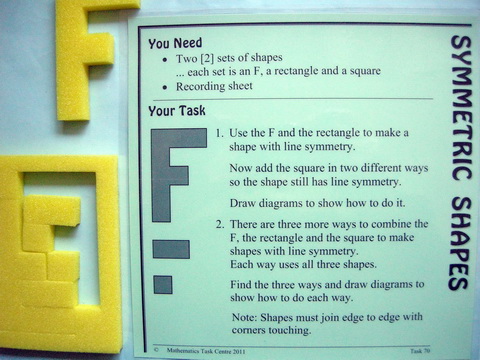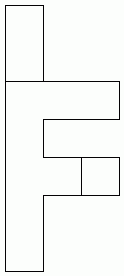
Symmetric ShapesTask 70 ... Years 2 - 10SummaryEach student has three pieces and has to make line symmetric shapes with them. Doesn't sound too hard does it, but it is a very different challenge to most text book examples on symmetry where the whole is given and what is asked for is the line of symmetry. One of the great values of the task is that there is more than one answer to some of the challenges. |
Materials
Content
|

IcebergA task is the tip of a learning iceberg. There is always more to a task than is recorded on the card. |
This task has its origins in the work of Geoff Giles and the DIME (Developments in Mathematics Education) Project. Find out more about Geoff Giles and Geometry (PDF) through this link to the Association of Teachers of Mathematics, UK, web site. The task begins with challenges which are quite achievable. Make a line symmetric shape from the F and the rectangle... 
Now add the square in two different ways to retain the line symmetry...  
So far so good, but there are three more ways to combine the F, the rectangle and the square to make shapes with line symmetry. These are much more of a challenge, especially since we may have been led into expecting the line of symmetry to be either horizontal or vertical. It takes a deal of thinking 'outside the square' to discover...  
When students are recording their drawings for this task ask them also to reflect on, and record, the clues that helped them solve each puzzle. This will help to broaden their understanding of symmetry and the mathematical operation of reflection which creates it. Additional challenges are:
|
Note: This investigation has been included in Maths At Home. In this form it has fresh context and purpose and, in some cases, additional resources. Maths At Home activity plans encourage independent investigation through guided 'homework', or, for the teacher, can be an outline of a class investigation.
- Visit the Home Page for more Background.
- For this specific activity click the Learners link and on that page use Ctrl F (Cmd F on Mac) to search the task name.
Whole Class InvestigationTasks are an invitation for two students to work like a mathematician. Tasks can also be modified to become whole class investigations which model how a mathematician works. |
Although the task may lose some of its kinaesthetic appeal by so doing, it could be converted to a whole class lesson by drawing the F, square and rectangle on the square paper supplied above as a recording sheet (several sets on a page), printing on card, and asking the students to cut them out to begin the investigation. The first purpose of the investigation would be to investigate and record properties of symmetry and reflection. Then the investigation can broaden as suggested by the questions above. At this stage, Symmetric Shapes does not have a matching lesson on Maths300. |
Is it in Maths With Attitude?Maths With Attitude is a set of hands-on learning kits available from Years 3-10 which structure the use of tasks and whole class investigations into a week by week planner. |
The Symmetric Shapes task is an integral part of:
|